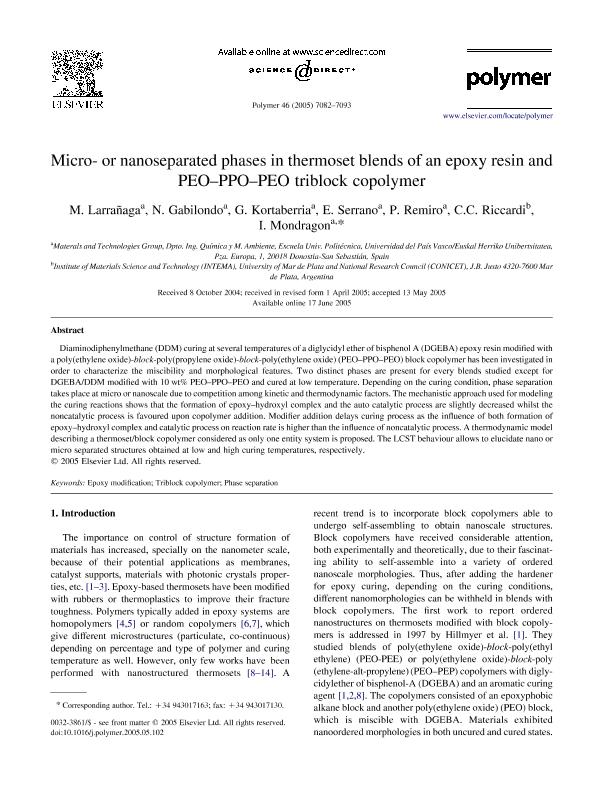Artículo
Micro- or nanoseparated phases in thermoset blends of an epoxy resin and PEO–PPO–PEO triblock copolymer
Larrañaga, M.; Gabilondo, N.; Kortaberria, G.; Serrano, E.; Remiro, P.; Riccardi, Carmen Cristina ; Mondragon, I.
; Mondragon, I.
 ; Mondragon, I.
; Mondragon, I.
Fecha de publicación:
08/2005
Editorial:
Elsevier
Revista:
Polymer
ISSN:
0032-3861
Idioma:
Inglés
Tipo de recurso:
Artículo publicado
Clasificación temática:
Resumen
Diaminodiphenylmethane (DDM) curing at several temperatures of a diglycidyl ether of bisphenol A (DGEBA) epoxy resin modified with a poly(ethylene oxide)-block-poly(propylene oxide)-block-poly(ethylene oxide) (PEO–PPO–PEO) block copolymer has been investigated in order to characterize the miscibility and morphological features. Two distinct phases are present for every blends studied except for DGEBA/DDM modified with 10 wt% PEO–PPO–PEO and cured at low temperature. Depending on the curing condition, phase separation takes place at micro or nanoscale due to competition among kinetic and thermodynamic factors. The mechanistic approach used for modeling the curing reactions shows that the formation of epoxy–hydroxyl complex and the auto catalytic process are slightly decreased whilst the noncatalytic process is favoured upon copolymer addition. Modifier addition delays curing process as the influence of both formation of epoxy–hydroxyl complex and catalytic process on reaction rate is higher than the influence of noncatalytic process. A thermodynamic model describing a thermoset/block copolymer considered as only one entity system is proposed. The LCST behaviour allows to elucidate nano or micro separated structures obtained at low and high curing temperatures, respectively.
Palabras clave:
EPOXY MODIFICATION
,
TRIBLOCK COPOLYMER
,
PHASE SEPARATION
Archivos asociados
Licencia
Identificadores
Colecciones
Articulos(INTEMA)
Articulos de INST.DE INV.EN CIENCIA Y TECNOL.MATERIALES (I)
Articulos de INST.DE INV.EN CIENCIA Y TECNOL.MATERIALES (I)
Citación
Larrañaga, M.; Gabilondo, N.; Kortaberria, G.; Serrano, E.; Remiro, P.; et al.; Micro- or nanoseparated phases in thermoset blends of an epoxy resin and PEO–PPO–PEO triblock copolymer; Elsevier; Polymer; 46; 18; 8-2005; 7082-7093
Compartir
Altmétricas



